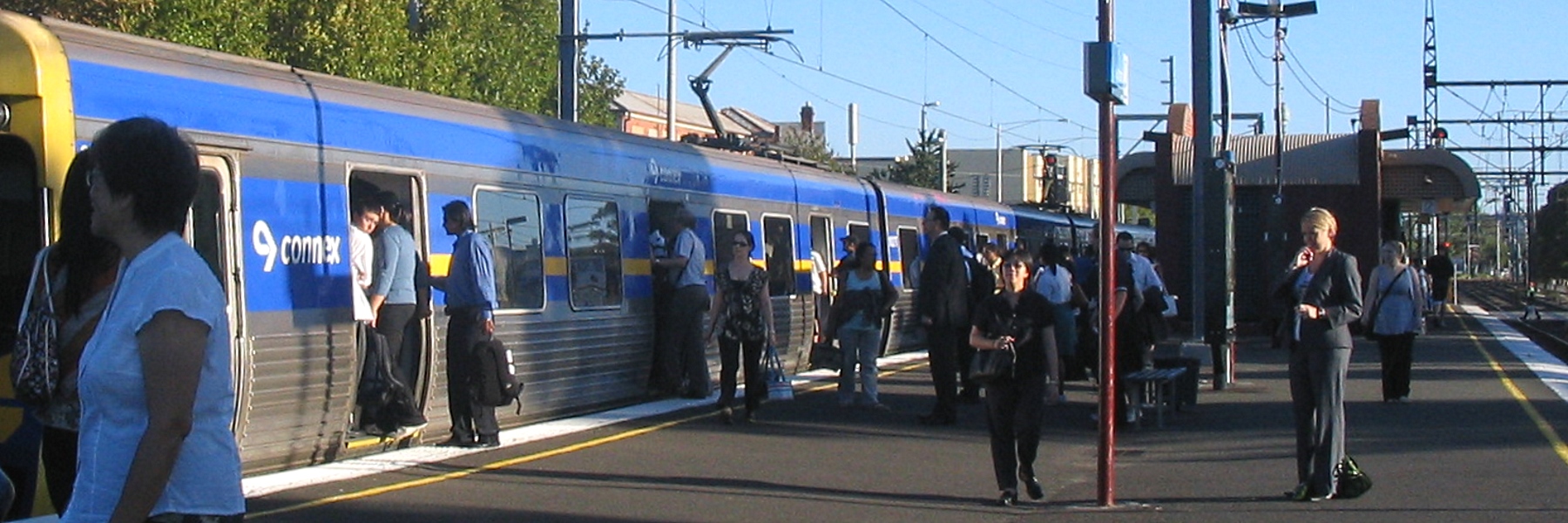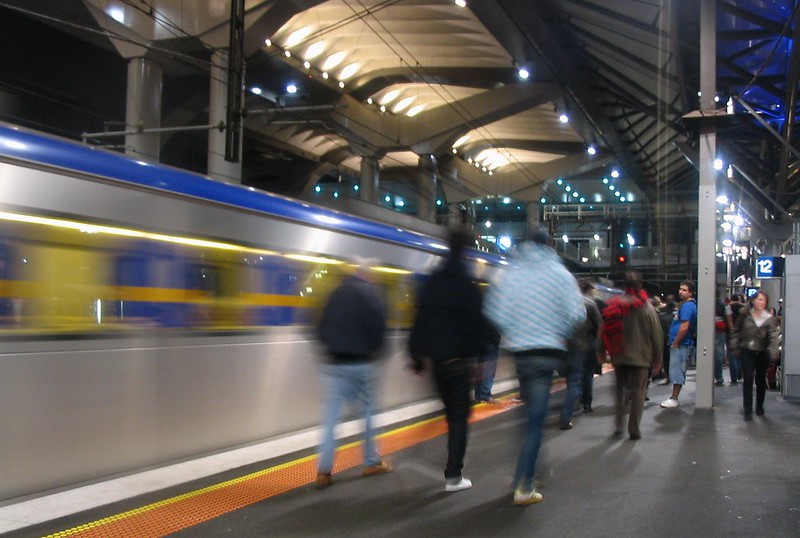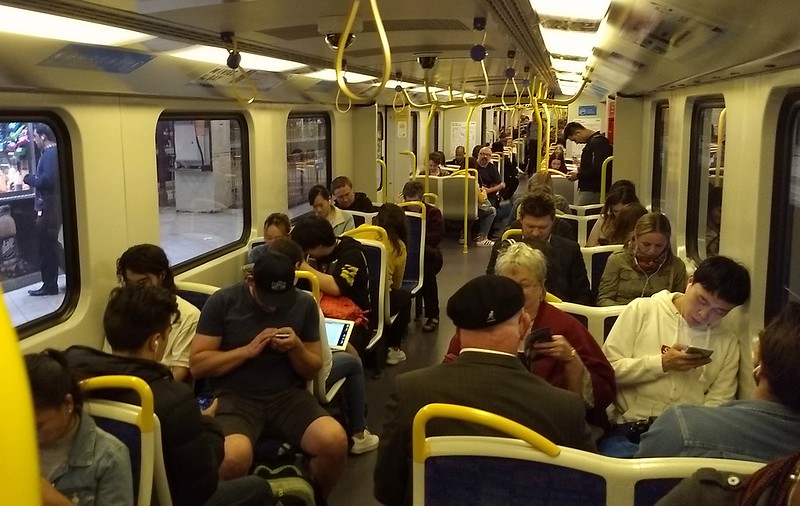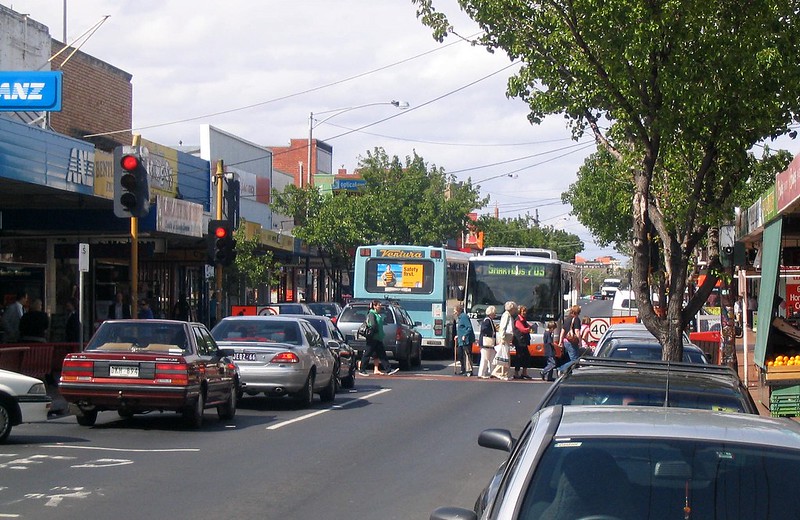Sometimes it’s easy to be cynical. Progress in public transport can be slow.
But there is some progress.
I found this from May 2007 — it was an email from me to a local politician who had asked about public transport issues in the southern suburbs of Melbourne.
I’ll intersperse my original points with some comments about progress in the past ten years. This focuses mostly on the Frankston line, but much is applicable to others.
Peak hour
Frankston line – while the Dandenong line has been earmarked for extra services, the Frankston line is also very crowded during peak hours, to the extent that passengers regularly can’t board trains. This is in part because some stations only get trains every 15 minutes (eg Glenhuntly, Ormond, McKinnon) even in peak hours.
Progress! There was a shake-up of the peak-hour timetable in 2014. Frankston line trains are mostly every 8-10 minutes now in peak, with a two-tier service so the load is spread between stopping and express trains.
In 2007, there were 16 trains into Richmond from the Frankston line between 7:01am and 9am. Now I count 21.
Other lines still need upgrades. The Ringwood line had an AM peak revamp, but PM peak is still a mess of different stopping patterns, which is confusing, and limits capacity.
Network-wide load standard breaches in 2009 numbered 54 (“above benchmark”) in the AM peak, and 48 in the PM peak.
By 2017, these had reduced to 17 and 7 respectively, helped by additional services, as well as modifications to carriages to provide more standing room (aka fewer seats) which led to the benchmark changing from 798 per train to 900. Cheating? Perhaps, but reflects a shift: it’s more important to just fit onto the train than for a few more people to get a seat.
Thanks to patronage growth, particularly residential growth around stations, there is still crowding at peak times, to the point where (to my eye) it is causing load breaches. And of course reliability is an issue — a cancellation causes widespread chaos.
Peak shoulder and inter-peak
Additionally, trains fall back to half-hourly after 7pm, which increases pressure on peak hour services, as people don’t want to wait half an hour for a train. Running frequent services (including expresses) for longer would allow more people to travel outside peak hours, and would not require any extra trains or infrastructure.
Progress! The last Frankston express train used to be at 6pm; they now run until about 6:40pm.
Where there used to be just two trains per hour after 7pm (departures from Flinders Street: 7:15, 7:45, then every half-hour), the Frankston line now has 5 departures out of the city between 7pm-8pm, then every 20 minutes until 10pm.
Some other lines have also improved, though the busy Sunbury and Craigieburn lines drop back to every 20 minutes at 6:30pm, then back to half-hourly at 8pm.
Between the peaks (during the day) things have improved on some lines. Trains between the peaks have run every 10 minutes all day on the Frankston line since 2011, with the Dandenong line following in 2014.
Other lines still need upgrades. Many are still only every 20 minutes during the day.
Evenings and weekends
Upgrades to evening and weekend services would also encourage more people to travel by train. At the very least, long trains should be used (overcrowding regularly occurs in evenings and weekends on the Frankston line and others), but more frequent services should also be provided.
Back then, most evening and weekend trains (when no football/cricket was on) ran as 3-cars.
Nowadays almost all services on all lines (except suburban shuttles) now run as 6-car trains, so the ridiculous situation of lots of people squeezing onto a short train rarely happens.
Evening frequencies: Many lines now run every 15-20 minutes until about 10pm, though on some it’s been implemented in a very hamfisted way. For instance Ringwood has the half-hourly service with 6-car trains, doing their old confusing Belgrave/Lilydale alternate through-train/shuttle arrangement, interspersed with extra 3-car trains to Ringwood. The timetable needs a complete re-write.
On weekends, trains out to Frankston, Ringwood and Dandenong have run every 10 minutes since 2012, doubling the previous daytime frequency. Most other lines still only get trains every 20 minutes.
After 8pm on weekends is pretty similar to how it was before; mostly half-hourly until midnight.
Southland station
Southland Station – this reached pre-feasibility stage in late 2004, and there has been no word on it progressing since then. Southland is a major activity centre, and serving it by rail should be a no-brainer.
Finally built and opened late last year! And from what I’ve seen, getting plenty of patronage.
Southland station busy with shoppers👍.
Up to two-thirds of people not spotting official path, or choosing not to use it. Really needs to be better signed and more direct. (Hint: nobody calls it "Westfield".) pic.twitter.com/N96od8fZpc— Daniel Bowen (@danielbowen) February 11, 2018
Buses
Many bus routes need upgrading, to provide better feeder services into stations (thus relieving overcrowded station carparks) as well as being more time-competitive for other trips. For instance, route 623 serves major destinations such as St Kilda Beach and Chadstone, but does not run on Sundays, is only hourly on Saturdays, and finishes by 6pm on weekdays.
Some small progress. In the late part of last decade, as part of the MOTC plan, many routes got Sunday and evening services added.
But frequencies haven’t improved. Most routes are still just half-hourly on weekdays, hourly on weekends and evenings. Not going to cut it for most people.
Level crossings
While upgrades to level crossings have helped safety, the government should be looking at elimination of crossings, such as the one removed at Middleborough Road, Laburnham earlier this year. Removing crossings can help train reliability, aid pedestrian amenity and safety, and help buses and trams by reducing traffic congestion. A prime candidate would be Glenhuntly Station, where both trains and trams have to cross very slowly, causing delays.
Definitely progress! After only a few grade separations in the past few decades, it’s happening in a major way now, with dozens to be done in the next few years.
There is progress
So there is progress, on some lines more than others.
Patronage has grown in this time: across Melbourne there were 162 million train journeys for 2005-06; this rose to 233 million in 2015-16 – an increase of 43%.
The upgrades are actually working, getting more people onto public transport. This is a good thing.
The question is: are these upgrades enough? Is the transport system keeping up? And is the rest of Melbourne getting what it needs?
Probably not. Many points of the rail network, and the greater public transport network, are under stress from crowding, and it’s not all at peak hour. The fast-growing western suburbs need particular attention.
On Wednesday, Julie Szego wrote in The Age that Melbourne is now a big city, with big city problems.
So while there’s been welcome progress on the trains in the last ten years, in the next ten we as a city need to see a lot more.
Big cities demand big city solutions. It’s not more motorways, it’s more mass transit, starting with frequent trains all day every day on every line.






10 replies on “Trains: has there been progress in ten years?”
In my experience in the northern suburbs, there have been marginal improvements while patronage has exploded, resulting in a significant decline in service quality. Off-peak and evening services are bad, but often standing room especially around the peak shoulder, where frequency falls back to every 20 mins almost immediately after about 8:45am, or every 30 mins after 8pm.
I have been taking the train that departs South Morang at 5:44am, which is standing room after Bell. Train services have slowed down significantly, with peak services taking up to 4-5 mins than they did, on top of their very slow speed. The inner section is now no faster than a brisk jog.
To be fair, there have been improvements in services to the East and South Eastern suburbs, Frankston line off-peak services seem to run very empty in particular, but overall it is falling far behind.
I have lived and commuted in Taipei and Singapore, and I have not seen such a combination of poor service and overcrowding in my times there. You’re much more likely to get a seat in Taipei in the shoulder peak than boarding a train from Thornbury or Northcote. You won’t be stuck waiting 30 mins for a train, to then have to stand another 30+ mins out to the suburbs in the early evening in Singapore or Taipei, despite those being really large, dense cities. I can absolutely see why some people insist we need catastrophically expensive toll roads like NE Link and the West Gate Tunnel when this is what the public transport alternative they experience is. The decline in bus standards with Transdev is not even worth mentioning.
“Southland Station – this reached pre-feasibility stage in late 2004”
That made me laugh!
A very positive piece, Daniel. Good one.
Daniel, how has patronage been like for Southland station?
How has it been, in respect to predictions, especially those seeking to use Southland S/C
Has there been any change in MyKi readings, where locals use Southland rather than Highet or Cheltenham for their commute to places like the city?
————–
Re Cambell, How are the commuting patterns like in Taipai and Singapore?
Do those cities have large CDBs like we have, or is that more spread out?
—————
I do note the massive changes and improvements to the network over the last 10 years. Including the RRL, and when was Sunbury electrified?
There are sure to be further improvements in the next few years, with the HCMT trains to start, and more services because of level crossing removal on various lines too.
The real event for future improvements shall be the next Victorian State Budget due out soon. There is sure to be a massive war chest of massive election year projects to be announced. Especially now we have an extra $2B?? from changing the GST carve up.
While no doubt, there shall be boosts to schools and hospitals as they should, and to roads also in that $2B boost for just one year, I can not see public transport being ignored.
10 minute frequency to Frankston and Dandenong weekday off-peak. From my observations, if you were to balance the number of passengers between the two more evenly, you’d revert Frankston back to 15 minutes (not that you would in reality, given the publicity of making services less attractive, and it would complicate the through-routing arrangement to Newport), and have trains every 6-7 minutes to Dandenong. As for other lines still stuck with 20+ minute weekday off-peak frequencies, it’d be interesting to see how many more journeys would be made if/when these lines finally get that mythical timetable overhaul.
I hope some boom gates are preserved – permanently open course but just there for people to see how life was like when level crossings existed.
Also, this nation is corrupt and road tunnels get built instead of railways. The longest road tunnel in London is only 1.8 km long and it was built in 1993: https://londonist.com/2016/05/london-s-longest-tunnels
I doubt road tunnels have been built in London since.
Compared to a decade ago, weekday train services between Dandenong and the city are frequent enough up to 9 pm that one can just turn up and catch the next service. One hopes that the new trains and level crossing removals will provide head room to add capacity for another decade before additional tracks are required. Service frequency between 9 pm to midnight, and Saturday and Sunday mornings doesn’t seem to have changed much and even an additional service per hour would dramatically improve the appeal of travelling in those periods.
I hope that in ten years time:
The Metro Tunnel will be finished (almost certain)
High capacity Metro trains will be running everywhere at high frequencies (possible)
The tram and train network will be disability access compliant (highly unlikely)
Dirty polluting buses will be phased out (possible)
Doncaster rapid transit will have been built (unlikely)
Bus lanes will have been implemented in Melbourne (possible)
Cycle infrastructure will be of a high quality across Melbourne (unlikely)
The Werribee line metro project will have started (likely)
Most trains in Melbourne are running as grade-separated driverless trains (possible)
A second round of grade separations is conducted (possible)
The EasternWesternWideRingGateTransLinkTunnelWay is completed and there are billions left for sane transport spending (highly unlikely)
Gone is the 40 minute wait on the Burnley group on Sunday nights, with Saturday frequencies taking over since 2012 (if only buses would do the same). Unfortunately the progress ends there and the weekend timetable is still every 30 minutes after 8PM (as is the weekday timetable) and involves a 6-carriage sardine can right up until the last train. Ringwood still bucks the trend of 6-carriage trains in the weekday evenings by running a few 3-car services in between the 6-car Belgrave and Lilydale trains (and with no 15-minute trains from Ringwood to the city after 8:36, which itself is a 3-car service), while Alamein still retains the 3-car shuttles from Camberwell even though it would make sense to run something slightly better than every half an hour between Camberwell and Richmond (the only exception is Burnley due to the Glen Waverley line).
Gone is the single track misery north of Keon Park, with the line formerly known as Epping being extended to South Morang (and soon Mernda), although the neighbouring Hurstbridge line is still in the 19th century beyond Eltham (at least Heidelberg-Rosanna will finally have two tracks very soon).
Gone are the noisy, non-air-conditioned Hitachi trains wreaking of burning brakes and feeling like a sauna in the middle of summer. X’Trapolis trains start running in revenue service on some “Bayside” lines, beginning with Frankston. Comeng trains all but disappear from the Burnley and Clifton Hill groups with these lines becoming almost 100% X’Trapolis, although there are still no signs of Siemens trains running on these lines.
Night Network has replaced the NightRider buses and (re)introduced all-night trains and a small handful of trams as well, although it could be considered a backwards step for some people, who have seen their former half-hourly bus service become an hour’s wait for the train. No signs of running all night transport on public holiday eves or during the week for late workers unfortunately, Melbourne is still taking baby steps and hoping that the government doesn’t axe the current service altogether.
Interesting article Daniel, but I note no mention of the Werribee line.
So the update for this line is yes there has been improvement, to the point that the majority of week day trains to/from Werribee, during business hours, are now express and don’t go via the Altona loop (this reduces the trip by approx. 20 minutes), early morning and after 7.00pm trains stop all stations.
While peak services have definitely improved, catch a train before 6.45am or after 5.30pm the services drops to every 20 minutes.
Weekend trains stop all stations every 20 – 30 minutes.
HCMT trains!! What HCMT trains? The only lines that will get these are the one where the platforms are either being rebuilt or extended – no such thing for the Werribee line.
@Deb, “I note no mention of the Werribee line.”
Well, no. The original email and query was about the southern suburbs.